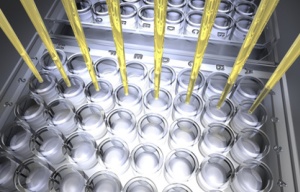A previous post explained how samples obtained from patients treated with mAbs can show interference with WB & ELISA methods. More rarely, we can also find other interference effects caused by different factors.
Immunoassay interference is typically caused by non-specific interactions between antibodies within the assay itself and endogenous antibodies present within a patient’s sample. Any type of interference can cause an assay to report a false result. This can be avoided by using a blocking reagent, whic h is a product designed to prevent interfering antibodies from adversely affecting immunoassay results.
h is a product designed to prevent interfering antibodies from adversely affecting immunoassay results.
Most ELISA immunoassays include mouse monoclonal antibodies. The most well-known type of interference is Human anti-mouse antibodies (HAMA), a type of heterophilic interference in which the HAMA antibodies are able to bind multiple and seemingly unrelated epitopes to cause false results. Rheumatoid factor (RF), an autoantibody that reacts with the patient’s proteins, can also cause interference through cross-reaction with animal Ig in the assay.
Typically, if you suspect sample interference with your ELISA, a blocking reagent must be added to the sample preparation prior to executing the assay.
A passive blocker is a preparation of normal animal immunoglobulins (e.g. mouse IgG), usually added in excess concentration to prevent interfering patient antibodies from binding to the assay antibody components by providing alternate/competitive binding sites.
An active blocker is designed to remove all types of heterophilic interference. It contains a specific binder directed against human heteroph ilic antibodies and once bound to the interfering antibodies, it blocks further binding to other assay components through steric hindrance. Active blockers can typically be used in lower concentrations than passive blocking reagents.
ilic antibodies and once bound to the interfering antibodies, it blocks further binding to other assay components through steric hindrance. Active blockers can typically be used in lower concentrations than passive blocking reagents.
Most of the ELISA manufacturers include blocking reagents to prevent false positive and false negative results and to enhance assay performance. These are usually present in buffers used to dilute the samples. Meaning that it is not recommended to exchange these sample preparation buffers between kits from different manufacturers, or even kits from the same manufacturer detecting different targets, as these buffers are specific to the antibodies used in the immunoassay.
In any case, interference caused by HAMA or other factors is a rare event for most commercial kits. You can always use risk-free trial programs if you fear that your samples may show interference, and we can advise on the control experiments that you can perform to check the validity of your results.
Have you ever experienced interference due to auto-antibodies or HAMA while using ELISAs? Please leave your comments!



